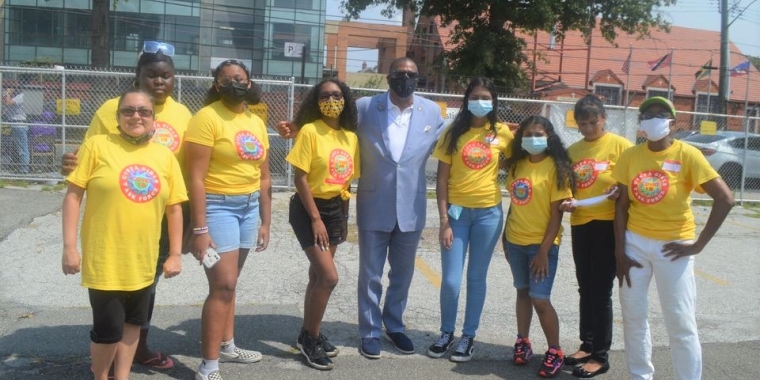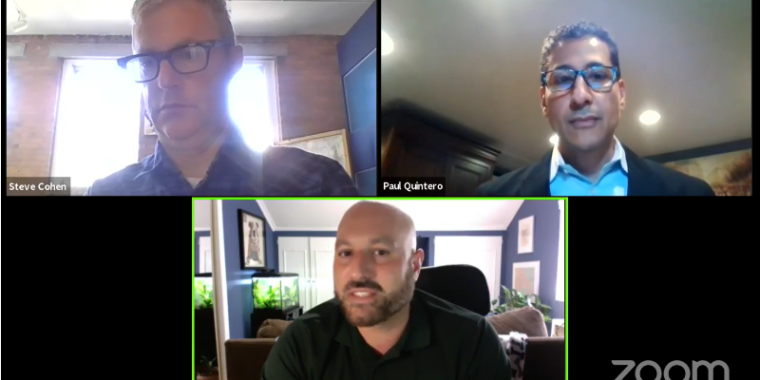
Sanders Hosts Meeting on Flooding, Coastal Storm Protection; Will Form Task Force
October 26, 2016

State Senator James Sanders Jr. (D-Rochdale Village, Far Rockaway) hosted a community meeting on Tuesday evening at Macedonia Baptist Church in Arverne where representatives from the U.S. Army Corps of Engineers and NYS Department of Environmental Conservation (DEC) presented the latest version of plans to address flooding and provide coastal storm protection for the Rockaway Peninsula, Broad Channel, the East Rockaway Inlet to Rockaway Inlet, and the Jamaica Bay Reformulation Study.
“Continuous flooding during high tide and disastrous weather have been plaguing the Rockaway community for years,” Senator Sanders said. “As someone who represents most of the Rockaways and as a life-long resident here, it is important for me to ensure that everyone who will be affected by this critically important plan, has his or her voice heard, and that the final version of the proposal is something that will best protect vulnerable areas from future storms.”
Dozens of residents attended the meeting, asked many questions and provided feedback on the Army Corps’ proposal. This is significant for two reasons. First, the public comment period is open and has been extended from November 2, 2016 through November 17, 2016, so there is still time for residents’ concerns to be taken into consideration before the plan is finalized. Second, Senator Sanders is seeking to put together a task force to monitor this plan as it moves forward, and this was an opportunity to bring community leaders together who might sit on the task force along with representatives from the Army Corps and DEC.
The Army Corps plan, is expected to be finalized in June 2017 with construction targeted to begin in 2019. It consists of four major components: addressing the shorefront, creating a storm surge barrier, implementing residual risk features and integrating additional elements tying into higher ground, according to Stephen Couch, Chief of the Hurricane Sandy Planning Branch of the U.S. Army Corps of Engineers.
The shorefront component will consist of building a composite sea wall structure along the Atlantic Ocean shoreline, which will generally extend from Beach 9th Street to Beach 149th Street and will include beach nourishment and the construction of 12 new additional groins. There will be a second phase that will extend from Beach 149th Street through the Seagate community and tie into a series of structural elements including levies, beach nourishment and a concrete floodwall, Couch said.
The plan also provides for a storm surge barrier east of the Gill Hodges Bridge which will include seven 100-foot vertical lift gates to allow for tidal exchange and two 200-foot wide sector gates to provide for the navigation of boats through the area. While the larger, more time consuming structures are being built, the U.S. Army Corps of Engineers will implement residual risk features to address flooding more quickly. These would include low berms, bulkheads, revetment, road raising, and eye walls (driving piling that would act as a flood barrier), according to Couch.
The entire presentation by the U.S. Army Corps of Engineers can be accessed online by going to the link below.
Among the issues raised by residents at the meeting was how the plan, once implemented, would affect flood insurance rates.
At this point, Couch said, the Corps has not determined with FEMA, what the impact would be, however they have started examining that issue as part of this current study. The answer, would depend on the outcome of an accreditation process, which essentially relies on whether the Corps can provide a guarantee that if a 100-year storm event impacts the area that the design would not be compromised as a result. This may be complicated by the fact that FEMA is updating its flood hazard maps. Couch added that since the cost of the Corps’ project would be close to $4 billion he understands that there is an expectation that it would lower insurance premiums, and he said they would have a definitive answer by the time the study is completed.
Others expressed concerns that the area east of Beach 9th Street is not included in the tentatively selected plan. Couch said the Corps noticed that concern late in the process, but that it is being taken into consideration, and they are examining other areas to the east that could be potential cut off points for the project instead.
Dr. Ed Williams, CEO of Ready Rockaway, asked what is being done immediately in terms of flood mitigation while residents are waiting for the Corps’ construction to begin. Couch stated New York City has a plan to raise and strengthen vulnerable shorelines. Its goal is to guard against sea level rise, and not for the purpose of storm surge protection, according to the New York City Economic Development Corporation (NYCEDC).
Selma Erey, the secretary of the Rockaway Bay Coastal Association, asked how low lying areas in historic Arverne, specifically Beach 76th Street to Beach 35th Street from the A-Train station to Jamaica Bay, which were devastated by Sandy would benefit from the proposal. She also stated that the area’s infrastructure and storm sewer system needs to be updated in order to handle flooding.
“Right now we are flooded regularly, and we are flooded in ways that are totally not livable,” Erey said. “They are certainly not hygienic and our children should not be exposed to these conditions.”
Couch said that residual risk features are a priority. Also, he said moving forward, as with any project that addresses coastal flooding, the Corps will evaluate whether proper drainage elements are in place. He added that specific design work will be discussed later in the process.
Those who would like to submit public comments on the plan can email them to Robert Smith at Robert.J.Smith@usace.army.mil or Daniel Falt atDaniel.T.Falt@usace.army.mil Comments can also be sent via postal mail to the address below:
Mr. Robert J. Smith, Project Biologist
U.S. Army Corps of Engineers, New York District
Attn: CENAN-PL-E, Rm 2143
26 Federal Plaza
New York, NY 10278
Share this Article or Press Release
Newsroom
Go to Newsroom
Understanding Why Some Groups Sabotage Protests
July 31, 2020


